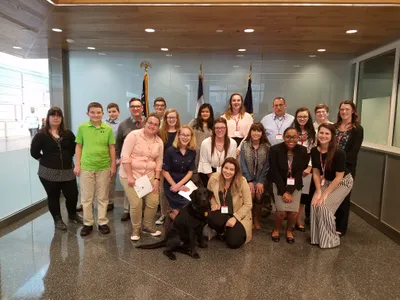Eberly News
Articles for the month of June 2018
WVU biology student receives NASA grant to study the brain
Kaylynn Coates, a doctoral student in the West Virginia University Department of Biology, has received a grant from the NASA West Virginia Space Grant Consortium to study how serotonin neurons are regulated in the brain.
WVU freshman wins National History Day award
New Mountaineer Brennan Lawless is off to a fast start as a West Virginia University freshman. The Daniels, West Virginia, native attended New Student Orientation on June 4, and won an award at National History Day just a week later.

Area youth tour FBI Biometric Center of Excellence with WVU Next Generation Forensic Science Initiative
For aspiring crime scene investigators, a personal tour of the FBI is what dreams are made of.
Psychology alumna elected as American Medical Association president-elect
Patrice A. Harris, M.D., a psychiatrist from Atlanta, Georgia, was elected as the new president-elect of the American Medical Association (AMA) June 12 by physicians gathered at the Annual Meeting of the AMA House of Delegates in Chicago.
WVU School of Social Work names 2018 Harbert Outstanding Achievement in Aging Award recipient
Susie Layne, program manager at the West Virginia Bureau of Senior Services, is the recipient of the West Virginia University School of Social Work’s 2018 Anita S. Harbert Outstanding Achievement in Aging Award.
WVU physicist receives prestigious NSF CAREER Award
In the heat of the space race in 1958 between the United States and the Soviet Union, James Van Allen discovered Earth’s radiation belt. The belt is located at 500 to 60,000 kilometers above Earth’s surface and is populated with energetic “killer” electrons that create a hazardous environment for satellites and other spacecrafts operating within this zone.
Debate Team director reflects on time at WVU
Samantha Godbey’s interest in the West Virginia University Debate Team sparked before she became a student when she spotted her coworker in a debate team t-shirt at a camp she worked at the summer before her freshman year.